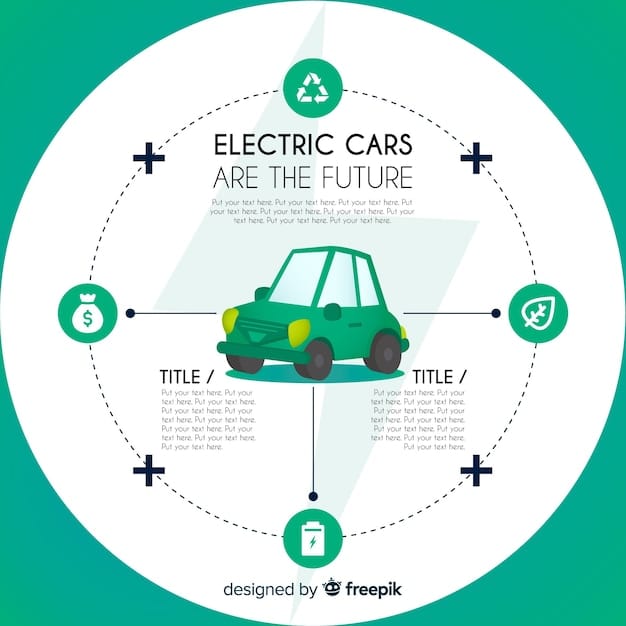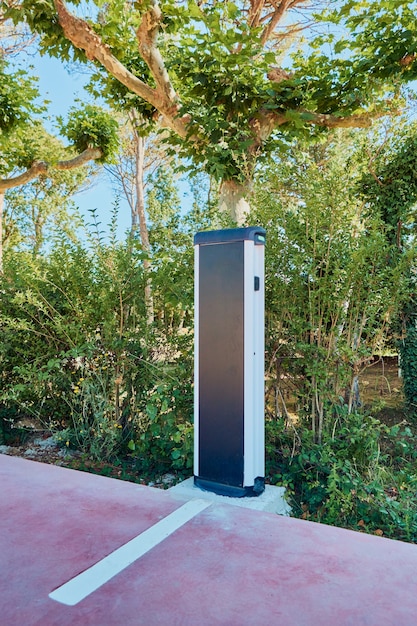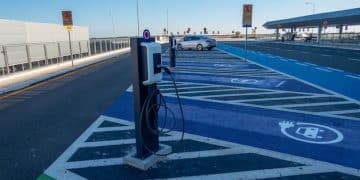Electric Vehicle Grid Integration: V2G Technology and Benefits

Electric vehicle grid integration, particularly through Vehicle-to-Grid (V2G) technology, allows electric vehicles to not only draw power from the grid but also supply it back, offering potential benefits such as grid stabilization, reduced energy costs, and enhanced renewable energy integration.
The rise of electric vehicles (EVs) presents a unique opportunity to revolutionize our energy infrastructure. Electric vehicle grid integration, specifically through Vehicle-to-Grid (V2G) technology, is at the forefront of this transformation, promising a future where EVs are not just consumers of electricity but also active participants in a smarter, more resilient grid.
Understanding Electric Vehicle Grid Integration
Electric vehicle grid integration refers to the process of connecting EVs to the electrical grid in a way that allows for bidirectional energy flow and communication. This integration goes beyond simply charging EVs; it enables them to interact with the grid, providing services such as energy storage, demand response, and grid stabilization.
What is Vehicle-to-Grid (V2G) Technology?
Vehicle-to-Grid (V2G) technology is a key component of electric vehicle grid integration. It allows EVs to not only draw power from the grid (vehicle-to-grid) but also to send power back to the grid (grid-to-vehicle).
Key Components of V2G Systems
V2G systems typically involve advanced charging infrastructure, communication networks, and control algorithms to manage the flow of energy between EVs and the grid.
- Smart Charging Stations: These stations enable bidirectional power flow and communication between the EV and the grid.
- Communication Networks: Secure and reliable communication networks are essential for transmitting data between EVs, charging stations, and grid operators.
- Control Algorithms: Sophisticated algorithms are needed to manage the charging and discharging of EVs in a way that optimizes grid stability and efficiency.

In essence, electric vehicle grid integration and V2G technology offer a pathway to a more sustainable and resilient energy future, where EVs play an active role in balancing the grid and supporting the integration of renewable energy sources.
Benefits of Electric Vehicle Grid Integration
The benefits of electric vehicle grid integration are far-reaching, impacting everything from grid stability to renewable energy adoption. By enabling EVs to interact with the grid, we can unlock a range of advantages that benefit both utilities and EV owners.
Grid Stabilization
EVs can provide ancillary services to the grid, such as frequency regulation and voltage support. By quickly responding to fluctuations in grid frequency and voltage, EVs can help maintain grid stability and prevent blackouts.
Reduced Energy Costs
EV owners can reduce their energy costs by charging their vehicles during off-peak hours when electricity prices are lower and selling excess energy back to the grid during peak demand.
Enhanced Renewable Energy Integration
Electric vehicle grid integration can facilitate the integration of renewable energy sources by providing a flexible storage solution. EVs can store excess renewable energy during times of high production and discharge it back to the grid when demand is high or renewable energy production is low.
These benefits underscore the transformative potential of electric vehicle grid integration, positioning EVs as key players in a cleaner, more reliable, and cost-effective energy landscape.
Challenges to Electric Vehicle Grid Integration
Despite the numerous benefits, there are significant challenges to overcome before electric vehicle grid integration can be widely adopted. These challenges range from technical hurdles to regulatory and market barriers.
Technical Challenges
One of the main technical challenges is ensuring the reliability and security of V2G systems. The grid needs to be able to handle the bidirectional flow of power from a large number of EVs without compromising stability or security.
Standardization and Interoperability
A lack of standardization and interoperability can hinder the deployment of V2G systems. Different EVs and charging stations may use different communication protocols and charging standards, making it difficult to ensure seamless integration.
In addressing these hurdles proactively, stakeholders can pave the way for a more widespread and effective implementation of electric vehicle grid integration.
Overcoming the Challenges
Overcoming the challenges to electric vehicle grid integration requires a multifaceted approach that involves technological innovation, policy support, and market development. Here are some key strategies for addressing these challenges:
Investing in Research and Development
Continued investment in research and development is essential for addressing the technical challenges of V2G systems. This includes developing advanced control algorithms, improving the reliability of charging infrastructure, and enhancing cybersecurity.
Establishing Standards and Protocols
Establishing industry-wide standards and protocols is crucial for ensuring interoperability and facilitating the deployment of V2G systems. These standards should cover everything from communication protocols to charging standards.

By proactively addressing these challenges, we can unlock the full potential of electric vehicle grid integration and create a more sustainable and resilient energy future.
The Role of Policy and Regulation
Policy and regulation play a critical role in driving the adoption of electric vehicle grid integration. Governments and regulatory bodies can create incentives for utilities and EV owners to participate in V2G programs, as well as establish clear rules and guidelines for the operation of V2G systems.
Incentives and Subsidies
Offering incentives and subsidies for V2G technologies can help reduce the upfront costs and encourage greater adoption. These incentives could include tax credits for purchasing V2G-enabled EVs and rebates for installing smart charging stations.
Regulatory Framework
Establishing a clear regulatory framework is essential for ensuring the fair and transparent operation of V2G systems. This framework should address issues such as grid access, compensation for ancillary services, and data privacy.
Proactive policies and regulations can pave the way for a more rapid and widespread adoption of electric vehicle grid integration, unlocking its full potential for a cleaner, more resilient energy grid.
The Future of Electric Vehicle Grid Integration
The future of electric vehicle grid integration looks promising, with ongoing advancements in technology, supportive policies, and growing market demand. As EVs become more prevalent and V2G technologies mature, we can expect to see even greater benefits for the grid and for EV owners.
Advancements in Technology
Ongoing research and development are leading to more efficient, reliable, and cost-effective V2G technologies. This includes improvements in battery technology, charging infrastructure, and control algorithms.
Wider Adoption of EVs
As the cost of EVs continues to decline and the availability of charging infrastructure increases, more consumers are expected to switch to EVs. This will create a larger pool of vehicles that can participate in V2G programs.
- Growing awareness of the benefits of V2G technology among utilities, EV owners, and policymakers.
- Increased collaboration between stakeholders to develop and deploy V2G systems.
- Continued innovation in battery technology and charging infrastructure.
The continued advancement of these factors will solidify electric vehicle grid integration as a cornerstone of a smarter, more sustainable energy future.
| Key Point | Brief Description |
|---|---|
| ⚡ V2G Technology | Enables EVs to send power back to the grid. |
| 🔋 Grid Stabilization | EVs provide frequency regulation and voltage support. |
| 💰 Reduced Costs | EV owners can charge during off-peak hours. |
| 🌱 Renewable Integration | EVs store excess renewable energy. |
FAQ
▼
Electric vehicle grid integration refers to the process of connecting electric vehicles to the electrical grid in a way that allows for bidirectional energy flow and communication.
▼
V2G technology allows electric vehicles to not only draw power from the grid but also send power back to the grid, providing services such as energy storage and grid stabilization.
▼
The benefits include grid stabilization, reduced energy costs for EV owners, enhanced renewable energy integration, and the potential to earn revenue by providing ancillary services to the grid.
▼
Challenges include technical issues such as grid reliability and security, standardization and interoperability, regulatory barriers, and market development.
▼
The future looks promising with advancements in technology, supportive policies, and growing market demand leading to wider adoption and greater benefits for both the grid and electric vehicle owners.
Conclusion
Electric vehicle grid integration, powered by Vehicle-to-Grid technology, presents a transformative opportunity to reshape our energy landscape. By enabling EVs to actively participate in the grid, we can unlock benefits ranging from enhanced stability and reduced costs to greater renewable energy integration. While challenges remain, ongoing innovation, supportive policies, and increased collaboration pave the way for a future where EVs are integral to a smarter, more sustainable energy ecosystem.





